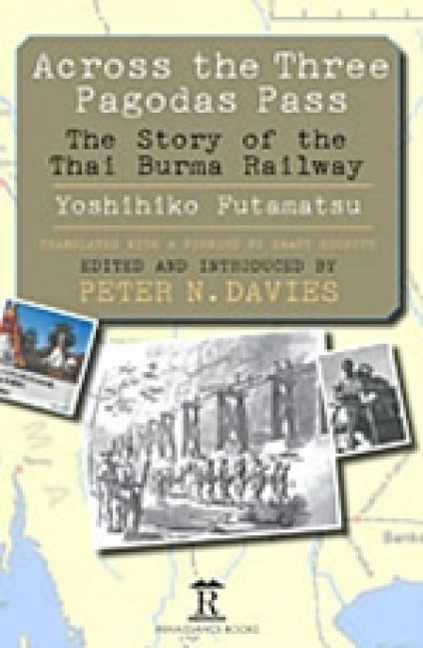Book contents
- Frontmatter
- Dedication
- Contents
- Acknowledgements
- Foreword
- Introduction
- Across the Three Pagodas Pass
- Translator’s Acknowledgements
- Preface
- Chapter 1 Departure for the Front
- Chapter 2 In Indo-China
- Chapter 3 Opening of Hostilities
- Chapter 4 The River Krian
- Chapter 5 The Malayan Campaign
- Chapter 6 The Fall of Singapore
- Chapter 7 Surrender
- Chapter 8 Shōnan: Light of the South
- Chapter 9 The Thai-Burma Railway
- Chapter 10 Preparing Construction
- Chapter 11 Banpong
- Chapter 12 Prisoners-of-War
- Chapter 13 Constructing the Railway
- Chapter 14 Thailand
- Chapter 15 The River Kwae Noi
- Chapter 16 The Mae Khlaung Bridge
- Chapter 17 Kanchanaburi
- Chapter 18 The Jungle
- Chapter 19 From Bangkok to Singapore
- Chapter 20 Rush Construction
- Chapter 21 The Base at Wanyai
- Chapter 22 The Labour Force
- Chapter 23 Survey Unit
- Chapter 24 Test Run
- Chapter 25 Bridge-Building and Shifting Earth
- Chapter 26 The Rainy Season: The Monsoon
- Chapter 27 Kinsaiyok
- Chapter 28 Diseases and Epidemics
- Chapter 29 Cattle Drive
- Chapter 30 Living in the Jungle
- Chapter 31 Soon to the Three Pagodas Pass
- Chapter 32 Towards the Setting Sun
- Chapter 33 Opening to Traffic
- Chapter 34 The Bombing
- Chapter 35 End of the War
- Chapter 36 Internment
- Chapter 37 Repatriation
- Footnote
- Postscript
- End Notes
- Glossary
- Bibliography
- Index
Chapter 28 - Diseases and Epidemics
Published online by Cambridge University Press: 13 May 2022
- Frontmatter
- Dedication
- Contents
- Acknowledgements
- Foreword
- Introduction
- Across the Three Pagodas Pass
- Translator’s Acknowledgements
- Preface
- Chapter 1 Departure for the Front
- Chapter 2 In Indo-China
- Chapter 3 Opening of Hostilities
- Chapter 4 The River Krian
- Chapter 5 The Malayan Campaign
- Chapter 6 The Fall of Singapore
- Chapter 7 Surrender
- Chapter 8 Shōnan: Light of the South
- Chapter 9 The Thai-Burma Railway
- Chapter 10 Preparing Construction
- Chapter 11 Banpong
- Chapter 12 Prisoners-of-War
- Chapter 13 Constructing the Railway
- Chapter 14 Thailand
- Chapter 15 The River Kwae Noi
- Chapter 16 The Mae Khlaung Bridge
- Chapter 17 Kanchanaburi
- Chapter 18 The Jungle
- Chapter 19 From Bangkok to Singapore
- Chapter 20 Rush Construction
- Chapter 21 The Base at Wanyai
- Chapter 22 The Labour Force
- Chapter 23 Survey Unit
- Chapter 24 Test Run
- Chapter 25 Bridge-Building and Shifting Earth
- Chapter 26 The Rainy Season: The Monsoon
- Chapter 27 Kinsaiyok
- Chapter 28 Diseases and Epidemics
- Chapter 29 Cattle Drive
- Chapter 30 Living in the Jungle
- Chapter 31 Soon to the Three Pagodas Pass
- Chapter 32 Towards the Setting Sun
- Chapter 33 Opening to Traffic
- Chapter 34 The Bombing
- Chapter 35 End of the War
- Chapter 36 Internment
- Chapter 37 Repatriation
- Footnote
- Postscript
- End Notes
- Glossary
- Bibliography
- Index
Summary
With the advent of the rainy season the hardships on the construction-sites were caused not only by the rain but also by fierce and terrifying air-raids by the enemy. There were, too, disease epidemics. In the River Kwae Noi area along which the route ran, in the river-basin people did not live right in the jungle, but some contracted malarial fevers and were subject to outbreaks of various other infections. The demon of ill-health represented a fact of life which had to be expected, threatening their lives. When outbreaks of fiercely contagious diseases occurred such as dysentery, cholera, bubonic plague and so on, they spread widely in a flash along the waters of the river. To the Thai, this was nothing new. When the Japanese Army were planning the railway construction, counter-measures against epidemics were considered in real earnest and so, after the first step of investigating a route for the railtrack itself, the question of prevention against epidemics in the water-supply was also considered. To make the interior of the jungle fit to live in one had to be prepared to investigate assured supplies of drinking water and so on. Precautionary measures were taken by the engineers against epidemics of infectious diseases and vaccination and immunization of Japanese troops were enforced. In the rainy season of 1942 few of the engineer units and a minority of prisoner-of-war labourers were affected by such conditions so it was possible to go a long way towards defence against invasion by this demon of disease. In 1943, the year in which in March, in the rainy season, the order for rush-construction was being enforced, river-flooding at the work-sites was widespread. Concurrently, numbers of prisoners and coolies were precipitately increased. The number of labourers reached a total of some 100,000 men. As you may well imagine, for such vast numbers, to take foolproof measures of protection was impossibly difficult to achieve. On top of that problem, it became difficult to transport food and fodder and the shortage of supplies for the entire workforce caused standards of nourishment to decline. A slump in general health continued, rehabilitation from fatigue was hampered, and few escaped illness of some sort or other. At times like these when attacked by viruses a patient's condition was likely to stop improving.
- Type
- Chapter
- Information
- Across the Three Pagodas PassThe Story of the Thai-Burma Railway, pp. 134 - 137Publisher: Amsterdam University PressPrint publication year: 2013



